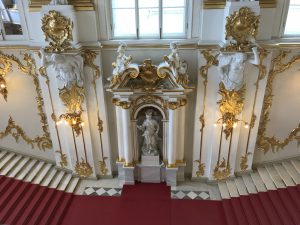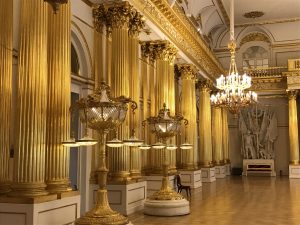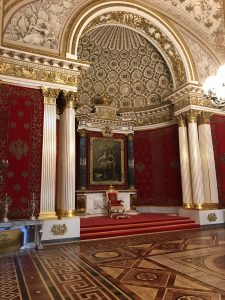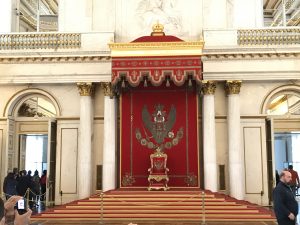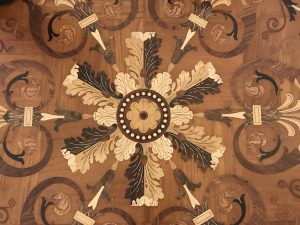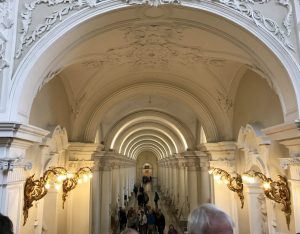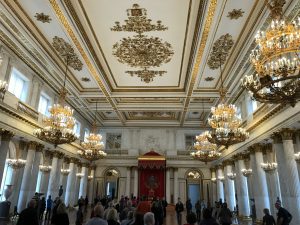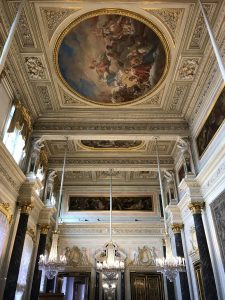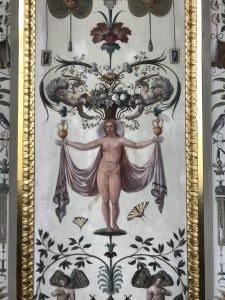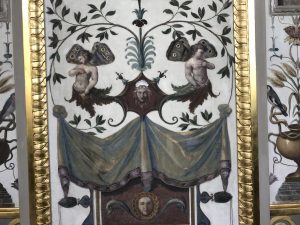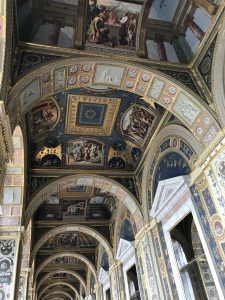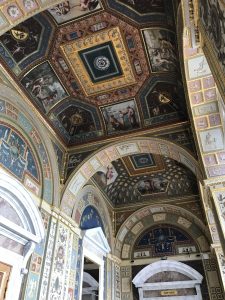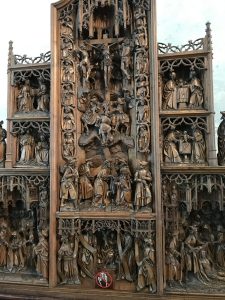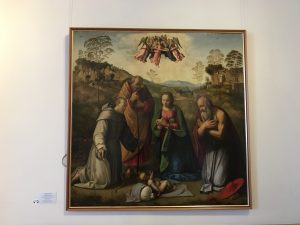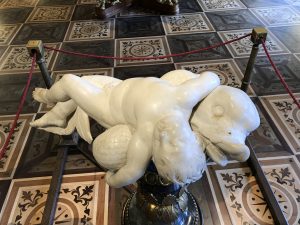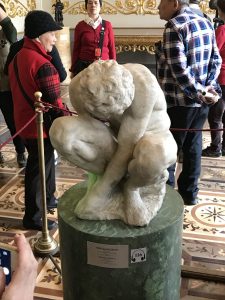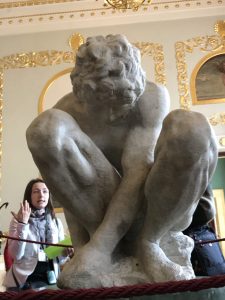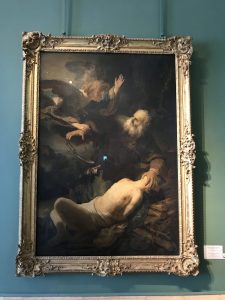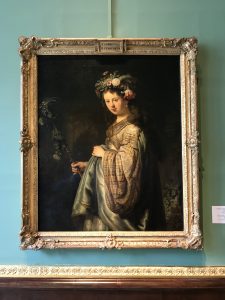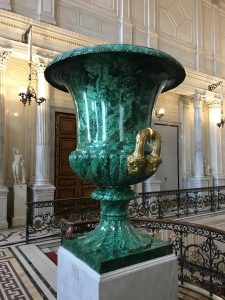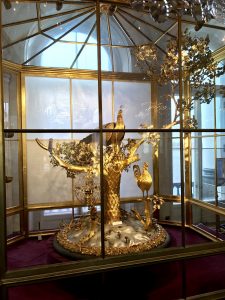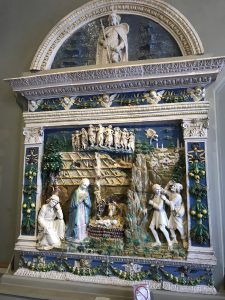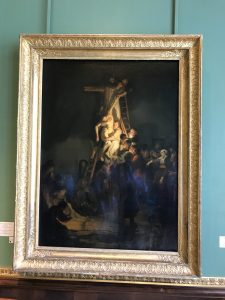Imperial Waterways of Russia
June 2, 2017
The Winter Palace, the Hermitage, and People
First, a reminder: This is one of three pages describing our time in St. Petersburg. The other two:
St. Petersburg
The Catherine Palace
This was what we were told was typical for St. Petersburg: a rainy day. We started out in a deluge a little earlier than we had the day before, we moved around in the rain, and it wasn’t until the end of the day that we began to see the sun. Of course, the sun didn’t think about setting until 10:00 PM or so, meaning we had a lot of rainy weather. It alternated with periods of relative calm, though, and the rain certainly didn’t lessen our lessons about Russian history. You’ll see what I mean as you skim through the prose below, but the main feature of this page is found in the many photographs below. Enjoy
The Winter Palace and the Hermitage
We started out with early entry into the Winter Palace, something the tour companies work out with the management. Thirty minutes doesn’t sound like a lot, but given the crowds we saw as we left later in the day, the early entry meant a lot! We made use of the free cloak rooms without any trouble, stashing rain gear and heavy bags, and made our way through the airport-like security to start our tour at the grand staircase, AKA Ambassador Staircase. Not a bad way to begin a tour at all.
It would be easy to say that I saw this as simply one more grand Baroque building and let it go at that. But each one of those grand edifices is unique in some way, and what unites them is less important than the differences. In some ways, 18th-century Czars outdid Louis XIV in terms of Baroque splendor, and I’m fairly certain Peter the Great must have had some of that in mind when he established the city itself. If for no other reason, he had more land and people to both generate wealth and do all the work.
I’m not going to say anything here about the layout of the buildings or anything, because anyone who wants to learn that can go hit Wikipedia, but I don’t mind saying that I learned a lot that day. Maybe the most important thing was learning that a “hermitage” in Russian culture was not just a dwelling place for a hermit, by extension a place for private contemplation, or a place to get away from it all. It could also be a place for enjoying beautiful things, which in itself is an act of contemplation, one best enjoyed alone where physical objects are concerned. Maybe not with music, drama, dance and other performances, but certainly with paintings, sculpture, etc. The light bulb happened. It took only 70 years for me to notice.
The Art
Trying to describe everything I saw in the Hermitages (Small, Old and New–see Wikipedia again) just wouldn’t work, so I’ll just concentrate on two things.
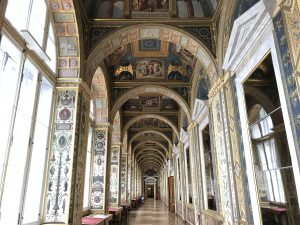 First of all, the Raphael Loggias, which I didn’t know about before I was standing in the middle listening to our guide. The Louis XIV concept of the absolute monarchy seems to have been in full force in eighteenth century Russia, because Catherine the Great certainly pulled off one of the most amazing examples of “extreme art envy” I’ve ever heard of. Not to make light of this or anything, but she liked the gallery in the Vatican Palace, couldn’t have it torn out and moved to St. Petersburg, and sent a team to Rome to make copies. Those copies were painted on fabric, brought back to Russia, and attached to the walls of the newly constructed gallery there. Not something your average art lover would be able to pull off, but if you’re an absolute ruler, you have the means and the desire, why not?
First of all, the Raphael Loggias, which I didn’t know about before I was standing in the middle listening to our guide. The Louis XIV concept of the absolute monarchy seems to have been in full force in eighteenth century Russia, because Catherine the Great certainly pulled off one of the most amazing examples of “extreme art envy” I’ve ever heard of. Not to make light of this or anything, but she liked the gallery in the Vatican Palace, couldn’t have it torn out and moved to St. Petersburg, and sent a team to Rome to make copies. Those copies were painted on fabric, brought back to Russia, and attached to the walls of the newly constructed gallery there. Not something your average art lover would be able to pull off, but if you’re an absolute ruler, you have the means and the desire, why not?
I was fascinated with both the origin and the appearance of that part of our tour. I’ve even put those photos in a separate tab of the page below.
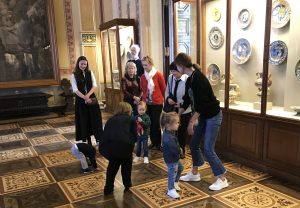 The other thing is something Judy noticed and brought to my attention: docents, or maybe parents, with small children being introduced to the museum. That was really quite charming, and it made a connection for us that simply couldn’t have been any stronger. Not only did Judy want to send photos to her docent friends at the BMA, but we both thought of our own girls and their introduction to the British Museum in 1985. Seeing those children might have been one of the most precious points of connection between two US citizens and Russian life we could have ever expected to see.
The other thing is something Judy noticed and brought to my attention: docents, or maybe parents, with small children being introduced to the museum. That was really quite charming, and it made a connection for us that simply couldn’t have been any stronger. Not only did Judy want to send photos to her docent friends at the BMA, but we both thought of our own girls and their introduction to the British Museum in 1985. Seeing those children might have been one of the most precious points of connection between two US citizens and Russian life we could have ever expected to see.
Priceless.
People
At the end of our tour, we struggled through the now huge and aggressive crowds, collected our rain gear, and found we had a decision to make. On the one hand, we could stay in the center of town, have lunch on our own again, and then go through some of the other museum buildings to see the greater collection of nineteenth- and twentieth-century art. On the other hand, we could return to the ship for lunch and a nap. We were still getting over the effects of long-distance travel and my stress over not having clean clothes for a couple of days, so the nap won the toss.
After recovery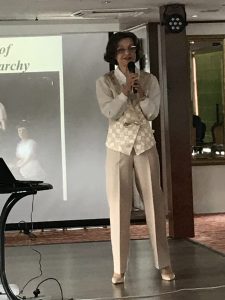 time in our cabin, we went up to the lounge for what was billed as the first of several daily lectures on Russian history. Uniworld had an arrangement with Prof. Dr. Inna Gritsenko to provide one-hour lectures daily throughout the cruise to give us background on Russia from Peter the Great through the present day. She was a wonderful presence on board the ship, and her preparation and delivery ideally suited to her “mature” audience. We both thoroughly enjoyed her first presentation as a prelude to the cocktail hour and dinner, and we decided later that her daily talks were one of the highlights of the cruise.
time in our cabin, we went up to the lounge for what was billed as the first of several daily lectures on Russian history. Uniworld had an arrangement with Prof. Dr. Inna Gritsenko to provide one-hour lectures daily throughout the cruise to give us background on Russia from Peter the Great through the present day. She was a wonderful presence on board the ship, and her preparation and delivery ideally suited to her “mature” audience. We both thoroughly enjoyed her first presentation as a prelude to the cocktail hour and dinner, and we decided later that her daily talks were one of the highlights of the cruise.
After appropriate libations, continuing our sampling of Russian vodkas, we went down to dinner and had the most fun we’d had so far. Jean Schumer and Dave Chalmers are from an island somewhere north of Seattle and south of British Columbia, while Robert and Cindy Hess live in Houston. Both couples are more well-traveled than we are, and we enjoyed learning about their experiences with cruises on ships large and small, and all the many exciting places they had visited. I think I laughed myself into tears before dessert was served. Judy and I headed up to the Katarina bar after dinner and laughed some more, and there we met two more people we would see a lot of over the next few days: our bartenders Vitalia and Egor.
Eventually we headed to bed, thinking of the next day’s trip to the village of Pushkin and our tour of the Catherine Palace and grounds.

